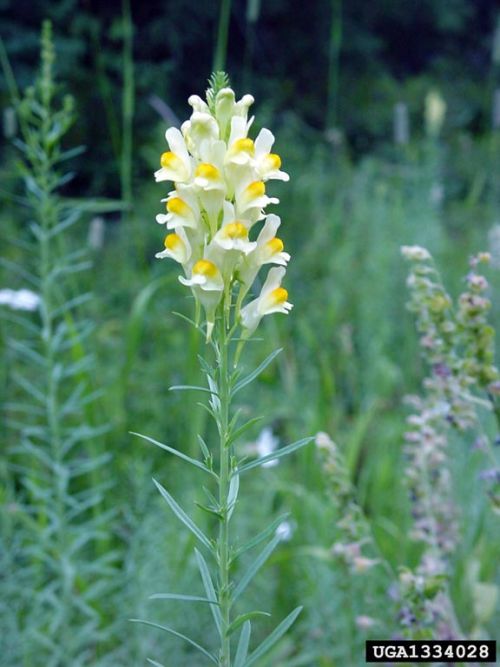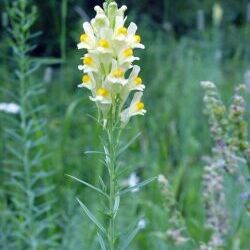
Priority: Contain
General: Garden plant that has snapdragon shaped flowers. The shape of the plant resembles a bottle brush.
Height: Grows between 10-80cm tall.
Flowers: Flowers look like snapdragons and are bright yellow. The flower clusters are attached to the stem by short equal stems at the top of the plant.
Leaves/Stems: Leaves are very thin and lance-shaped. They are pale green and grow from the stem alternately. The lower leaves are crowded. Stems are smooth with 1-25 floral stems at the top.
Root: Taproot and lateral roots with buds. The root can reach to 1m in depth.
Butter and Eggs, Wild snapdragon, Common Toadflax
Dalmatian Toadflax, invasive plant.
Differences: The way you can tell the difference between the 2 toadflaxes is by the leaves. Dalmatian toadflax has shorter, wide, waxy leaves that clasp the stem.
Where did it come from? Eurasia. Introduced as a garden ornamental.
Where does it grow here? Grows in a variety of environments especially disturbed sites like roadsides, cultivated fields, gravel pits, railway tracks and logging roads. In our region, it has been found in all environments including gravel pits, logging roads and hydro line access roads. It is well established on the roads near Gun Lake.
Reproduction: By seeds, roots and root buds. One plant can produce up to 30000 in one year. Seeds can stay viable in the soil for up to 10 years.
When does it grow, flower & seed? Sprouts in March-April. Flowers May-July. Seeds August-October.
Spreads By: Wind is the primary method of spread. Water and ants have also been reported to spread this plant. Grading, mowing and logging activities is also suspected in our region due to where this plant has been found.
Plant Type: Perennial.
- Mildly poisonous to livestock. It contains a substance called glucoside. It is unpalatable to livestock so poisonings are rare.
- It can reduce the presence of native plants because it takes over areas.
- Reduce the forage production of rangelands.
- Review your property regularly for this species.
- Treatment Remove small patches before it flowers & sets seed. Mowing and cutting will reduce seed but will not kill or remove this plant entirely. Handpulling repeatedly and removing the roots can work for small patches in combination with cover seeding the same area. Plants should be pulled a few weeks after they emerge in the spring before they grow the lateral roots.
- Cover bare patches or disturbed soil by planting or seeding with non-invasives.
- Check areas where you have removed invasives for any new plants that year and in future growing seasons.
- Dispose of invasive plants responsibly. Bag them for disposal at the local landfill. Composting and burning are not recommended.
- Contact LRISS for specific treatment recommendations.
